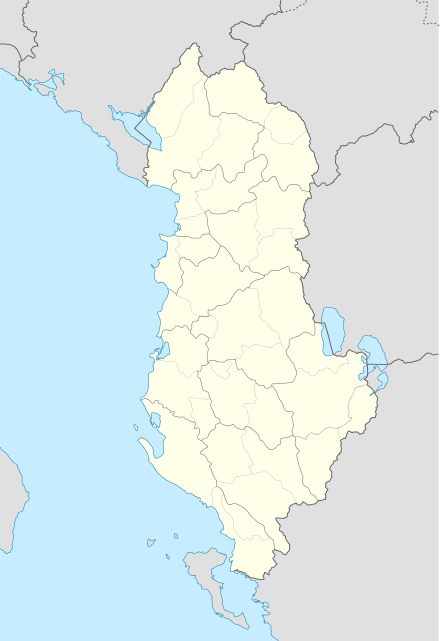Grilë
| Grilë | |
|---|---|
| Village | |
 Grilë | |
| Coordinates: 42°7′52″N 19°29′8″E / 42.13111°N 19.48556°ECoordinates: 42°7′52″N 19°29′8″E / 42.13111°N 19.48556°E | |
| Country |
|
| County | Shkodër |
| Municipality(s) | Malësi e Madhe |
| Time zone | UTC+1 (CET) |
| • Summer (DST) | UTC+2 (CEST) |
Grilë is a settlement in the former Gruemirë municipality, Shkodër County, northern Albania.[1] At the 2015 local government reform it became part of the municipality Malësi e Madhe.[2] It is part of the Vraka region, inhabited by a majority of Serbs–Montenegrins, who call the village Grilj.
History
1990
In 1990, there were 85 households, of which 76 were Montenegrin and 9 were Albanian. Of a total of c. 750 people, c. 680 are Montenegrins, the rest Albanians.[3] Descendants of various Montenegrin clans live in the village. Most numerous are the families of Zlatičanin (now bearing the surnames Krsto-Krstaja and Faticaj), then Peljčić (Šeljčaj), Krstović (Nikola and Nikolaj), Camaljić (Mino), Hajković (Hajku), Brajović (Ferizaj, Jako and Foljeta) and others.[3] There is only one primary school in the Vraka region, located in Grilë, having had c. 450 pupils in 1990. The teachers were mainly Albanians, though at times teachers were from Vraka.[3] The education was strictly in Albanian language, which led to great uninterest in education in the children, principally due to them not speaking Albanian before entering school; this is believed to be one of the causes that the educational success of children in Vraka was low.[3] However, the number of those who continued studies had increased in the last period, which had up until then been rare.[3]
2010s
During the early 2010s linguists Klaus Steinke and Xhelal Ylli seeking to corroborate villages cited in past literature as being Slavic speaking carried out fieldwork in settlements of the area.[4] Grilë in the Shkodër area is one of a number of villages with a Slavophone population that speak a Montenegrin dialect.[4]
The village of Grilë officially has 1,090 inhabitants or 195 families, while the number of Orthodox Montenegrin families there varies between 2, 3 - 10.[5] An Albanian school exists in Grilë along with a newly built Orthodox church that is without a priest.[5] According to Slavophone locals, the Orthodox population moved to Darragjat due to blood feuds related with Montenegro and relocated themselves to the Vraka area such as Grilë between 1935-1936.[5] Some Orthodox Montenegrins from the village moved to Montenegro in the 1990s with some thereafter returning to Grilë.[5]
References
- ↑ "Location of Grilë". Retrieved 26 August 2010.
- ↑ Law nr. 115/2014
- 1 2 3 4 5 "Najnoviji demografski i drugi podaci o Vraki".
- 1 2 Steinke, Klaus; Ylli, Xhelal (2013). Die slavischen Minderheiten in Albanien (SMA). 4. Teil: Vraka - Borakaj. Munich: Verlag Otto Sagner. ISBN 9783866883635. p. 9. "Am östlichen Ufer des Shkodrasees gibt es heute auf dem Gebiet von Vraka vier Dörfer, in denen ein Teil der Bewohner eine montenegrinische Mundart spricht. Es handelt sich dabei um die Ortschaften Boriçi i Madh (Borić Veli), Boriçi i Vogël (Borić Mali/Borić Stari/Borić Vezirov), Gril (Grilj) und Omaraj (Omara), die verwaltungstechnisch Teil der Gemeinde Gruemira in der Region Malësia e Madhe sind. Ferner zählen zu dieser Gruppe noch die Dörfer Shtoji i Ri und Shtoji i Vjetër in der Gemeinde Rrethinat und weiter nordwestlich von Koplik das Dorf Kamica (Kamenica), das zur Gemeinde Qendër in der Region Malësia e Madhe gehört. Desgleichen wohnen vereinzelt in der Stadt sowie im Kreis Shkodra weitere Sprecher der montenegrinischen Mundart. Nach ihrer Konfession unterscheidet man zwei Gruppen, d.h. orthodoxe mid muslimische Slavophone. Die erste, kleinere Gruppe wohnt in Boriçi i Vogël, Gril, Omaraj und Kamica, die zweite, größere Gruppe in Boriçi i Madh und in Shtoj."
- 1 2 3 4 Steinke & Ylli 2013, p. 111. "Gril - Grilj. In Gril leben offiziell 1.090 Einwohner bzw. 195 Familien. Die Angaben über die Zahl der orthodoxen Familien der montenegreschen Minderheit schwanken zwischen zwei bis drei und zehn. Hier befindet sich die die albanische Schule für Vraka und ferner eine neugebaute orthodoxe Kirche, die freilich keinen Priester hat. Die orthodoxen Einwohner sollen zunächst wegen der Blutrache von Montenegro nach Daragjat und von dort 1935-1936 nach Vraka gezogen sein, wie VK angbit. Er ist auch einer der wenigen Rückkehrer, der am Anfang der 1990-er nach Montenegro ging und wider zurückkam."
